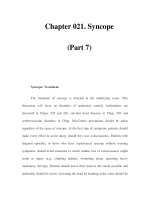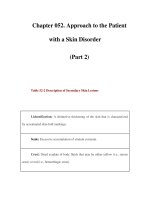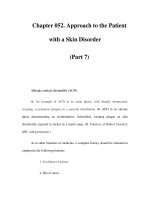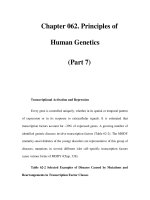Chapter 122. Acute Infectious Diarrheal Diseases and Bacterial Food Poisoning (Part 7) potx
Bạn đang xem bản rút gọn của tài liệu. Xem và tải ngay bản đầy đủ của tài liệu tại đây (14.72 KB, 5 trang )
Chapter 122. Acute Infectious Diarrheal Diseases
and Bacterial Food Poisoning
(Part 7)
Age
Most of the morbidity and mortality from enteric pathogens involves
children <5 years of age. Breast-fed infants are protected from contaminated food
and water and derive some protection from maternal antibodies, but their risk of
infection rises dramatically when they begin to eat solid foods. Infants and
younger children are more likely than adults to develop rotavirus disease, while
older children and adults are more commonly infected with norovirus. Other
organisms with higher attack rates among children than among adults include
enterotoxigenic, enteropathogenic, and enterohemorrhagic E. coli; C. jejuni; and
G. lamblia. In children, the incidence of Salmonella infections is highest among
those <1 year of age, while the attack rate for Shigella infections is greatest among
those 6 months to 4 years of age.
Bacterial Food Poisoning
If the history and the stool examination indicate a noninflammatory
etiology of diarrhea and there is evidence of a common-source outbreak, questions
concerning the ingestion of specific foods and the time of onset of the diarrhea
after a meal can provide clues to the bacterial cause of the illness. Potential causes
of bacterial food poisoning are shown in Table 122-4.
Table 122-4 Bacterial Food Poisoning
Incubation Period,
Organism
Symptoms
Common Food
Sources
1–6 H
Staphylococcus
aureus
Nausea, vomiting,
diarrhea
Ham, poultry,
potato or egg salad,
mayonnaise, cream
pastries
Bacillus cereus
Nausea, vomiting,
diarrhea
Fried rice
8–16 H
Clostridium
perfringens
Abdominal
cramps, diarrhea
(vomiting rare)
Beef, poultry,
legumes, gravies
B. cereus Abdominal
cramps, diarrhea
(vomiting rare)
Meats, vegetables,
dried beans, cereals
>16 H
Vibrio cholerae Watery diarrhea Shellfish
Enterotoxigenic
Escherichia coli
Watery diarrhea
Salads, cheese,
meats, water
Enterohemorrhagic
E. coli
Bloody diarrhea
Ground beef, roast
beef, salami, raw milk, raw
vegetables, apple juice
Salmonella spp. Inflammatory
diarrhea
Beef, poultry, eggs,
dairy products
Campylobacter
jejuni
Inflammatory
diarrhea
Poultry, raw milk
Shigella spp. Dysentery
Potato or egg salad,
lettuce, raw vegetables
Vibrio
parahaemolyticus
Dysentery Mollusks,
crustaceans
Bacterial disease caused by an enterotoxin elaborated outside the host, such
as that due to Staphylococcus aureus or B. cereus, has the shortest incubation
period (1–6 h) and generally lasts <12 h. Most cases of staphylococcal food
poisoning are caused by contamination from infected human carriers.
Staphylococci can multiply at a wide range of temperatures; thus, if food is left to
cool slowly and remains at room temperature after cooking, the organisms will
have the opportunity to form enterotoxin. Outbreaks following picnics where
potato salad, mayonnaise, and cream pastries have been served offer classic
examples of staphylococcal food poisoning. Diarrhea, nausea, vomiting, and
abdominal cramping are common, while fever is less so.









